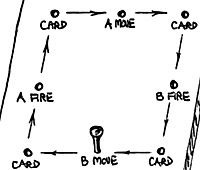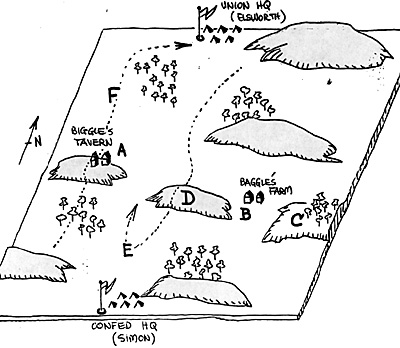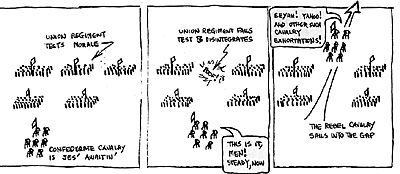 Introduction
Introduction
In the preceding article, Tom Elsworth described a battle in the PACMAN campaign. My stalwart army, The Hammer of Jahwehq defeated his because of a scarcity of ammunition amongst his units.
The result was that out of an original 1000 Amy Points (AP), I won the field but was down to 900 AP. Before I could recover, Tom attacked again with another 1000 AP and, this time, it was my turn to suffer an ammunition problem.
I had, during the first battle, used up all my Ammunition Points (AMP's). For the second battle, therefore, since Tom attacked before I could replenish either AP's or AMP's, I was down in numbers and up in the probability of several units running out of ammunition.
Two pre-battle dice throws decided: first, none of Tom's attacking units would suffer from a lack of ammunition (he devoted 90 AMP's to ensure this), while, second, for me, the first time a unit fired there would be a 30% chance it wouldn't fire again, i.e., be out of ammo for the rest of the game.
Tom had set the terrain features out during the first battle when he fought it at his wargames club at Oxford. Since I had been attacked on this same field, I used the same terrain elements: a parallel number of ridges, as shown on the map. The essential difference was that Tom had placed his encounter in the western desert, a microarmor battle, whereas mine was defined to be an American Civil War battle. While using the basic series of ridges, therefore, what I did was to dot the landscape with clumps of woods to give the table an "ACWish" appearance.
On the table, I set out my entire ACW 15mm inventory. These had been purchased, prepainted, over a year before at HISTORICON '87, and I had never used the entire array in a single battle before, indeed, I had never really counted the number of units I actually owned. After setting out the infantry and cavalry and artillery and appropriate standards, it turned out that each side had approximately the following:
- Infantry 24 regiments, each of 5 stands, and sorted out
into brigades of two and three regiments each.
Cavalry Two regiments, each of 5 stands.
Artillery Around 24 guns and limbers, divided into twelve 2-gun batteries.
The total force per side, therefore, could be likened to two divisions, or one small corps. Remembering that Tom's force outnumbered mine, 1000 AP to 900 AP, I gave Tom's Union troops a superiority in artillery, 15 batteries to 11.
Since Tom was attacking me on a field on which I had just been victorious, I assumed that an equitable initial disposition would be to: have my Confederate units set up - a maximum of 24 inches from my baseline - while the Union marched onto the table.
In the previous western desert battles two small Italian villages had been placed midfield... these became Baggle's Farm in the east and Biggle's Tavern in the west. I added two new features: the Union and Confederate HQ camps. These last two were quite valuable, as the following chart shows:
- Biggle's Tavern 10 Victory Points
Baggle's Farm 10
Union HQ 20
Confederate HQ 20
Capture of enemy cannon 5
The basic rules that were used were described in the November '87 REVIEW in the refight of Manassas. This is a "morale game* in which a tally of Victory Points (VP) determines the winner and loser. VP are earned for winning melees, for captured cannon, for enemy units falling back, etc.
The sketch shows a playing aid which helps to track the sequence. A golf tee as a marker denotes which phase of the sequence is taking place.
Note that the basic sequence uses the 'A Move/B Fire routine. Interspersed between the "normal" or regular phases of this sequence, however, are a series of card draw phases. The card deck is composed of the following:
- Side A, fire 2 cards
Side B, fire 2
A and B, fire 1
A, double move 1
B, double move 1
Side A, morale test 2
Side B, morale test 2
Side A, rally 1
Side B, rally 1
Melee 6 Total: 20 cards
In the flow of the sequence, as the marker is moved around the playing aid, each side knows, predictably, when its "normal" fire and movement phases will occur. During the card-activated phases, however, the random factor comes into play, and it cannot be predicted which of the fire, melee, move, etc., cards will be drawn. The sequence, therefore, is a mix of known and unknown subsequences.
Note that there are six special Melee cards in the deck. Combat is not resolved, even though two opposing forces may be placed nose to nose,' until a Melee card is drawn. After being placed face-to- face, therefore, two units may fire* move, pull back, etc., until they are committed to the melee by the draw of the Melee card.
In most of the Simon/Elsworth encounters, Fred Haub usually takes Tom's place and, most of the time, scores a victory for Tom. Here, however. I recruited Fred for my own, the Confederate, side.
 The map is annotated to show the highlights of the battle.
The map is annotated to show the highlights of the battle.
HIGHLIGHTS OF THE ENCOUNTER
Point A
Confederate Commander Haub quickly occupied Biggle's Tavern on the western edge. The Union never offered any threat here.
Point B
The Union, just as quickly, seized Baggle's Farm in the east and held on despite repeated Rebel attacks. Several waves of Confederate troops moved into "contact", and waited until a Melee card appeared for combat to begin. Each times the defending Union troops were lucky enough to pass through their fire phases before a Melee card was drawn, and each time the fire phase occurred, the Yanks would blast the Rebs, and the result was that when the Melee card finally showed up, the attacking Southerners were too weak to prevail.
Point C
The Union trundled four guns, two batteries, to the slopes just to the east of Baggle's Farm. Four guns, at 5 VP each* meant 20 Victory Points, a target too tempting to ignore, and the Rebs charged the hill. One brigade finally made it, and the guns were taken.
This was not the end of it, for several counterattacks later* the Union recovered the cannon.
In melee, each stand had an initial value of 10, less 1 for every time the unit had been impacted by fire. The total value of the regiment was multiplied by a 10-sided die roll and the high number won. The loser either fell back, or was taken from the field to be rallied later.
Point D
Haub's Confederates set up a grand battery of eight guns on the ridge Just east of Biggle's Tavern. These, too, were a tempting target... 40 VP were up for grabs... and on came the Union. The Confederates couldn't stop the attack, but Fred managed to get over half of his guns to safety. I believe two were taken.
Point E
The Union troops that captured the guns didn't stop on the ridge. On they came, seeking to break through to the Confederate camp, a 20 VP target. This caused a wee bit of confusion in the Southern ranks as several units were drawn out of the front lines and brought back to defend the HQ encampment. Enough troops were finally assembled to dissipate the threat; the Southern HQ was saved.
When firing, each stand of a 5-stand regiment had a 20% chance of impacting on a target, hence the 5-stand regiment's cumulative percentage. was 100%, producing an automatic impact. An impact marker was placed on the targetq and 'stayed there until a Morale card was drawn. The Morale Level (ML) was:
- ML = 60 + (5 x No of stands) - (5 x No of markers)
If a morale failure occurred, one of two things happened:
- a. Dice throw was odd. The regiment fell back, lost
a stand, received another marker, and the opposition got
1 VP.
b.Dice throw was even. The regiment routed from the field. It was taken from the table (it could be rallied later) and the opposition got 4 VP.
Point F
The Union camp, 20 VP, fell to a surprise breakthrough of the Yankee lines by Fred Haub's Rebel cavalry. Fred's troops had been trading fire with the Yanks just north of Biggle's Tavern, with neither side really getting an edge.
 The sketch shows how the good General Haub profited
from a Union failed-morale test. Of three Yankee
regiments in line. the middle failed; its dice throw was
even and it disintegrated; off the field it went. This
left a gap between the remaining two regiments, and
before it could be sealed, a Rebel Double-Move card was
drawn and into the gap sailed the Confederate cavalry.
The sketch shows how the good General Haub profited
from a Union failed-morale test. Of three Yankee
regiments in line. the middle failed; its dice throw was
even and it disintegrated; off the field it went. This
left a gap between the remaining two regiments, and
before it could be sealed, a Rebel Double-Move card was
drawn and into the gap sailed the Confederate cavalry.
A double move for the cavalry totaled 30 inches and one move later, the mounted troopers entered the Union HQ, picking up their 20 VP.
Despite the relatively large percentage, 30%, that each of my units would discover it had run out of ammunition, I was relatively lucky. I had 24 infantry regiments# 2 cavalry regiments and 11 batteries... 37 units in all. Yet only six or seven found their ammo stocks depleted, well below average. For the m'ost parts the infantry units that were out of bullets were put in the frofit ranks told to fix bayonets, and to take out their frustrations on the enemy. Some did, most didn't.
The Final Tally
Simon's Confederates 97 VP
Elsworth's Yanks 81 VP
Not a resounding victory, but a victory nontheless. Once again* The Hammer of Jahweh had come through.
FINAL THOUGHTS
As I mentioned, I had set out every ACW 15mm figure I owned. In part, it was a test of the rules, to see if the procedures could efficiently accommodate two forces that just about filled up the table. In short, I momentarily succumbed to the 15mm ailment also known as the fill-up-every-square-inch-of-the-table syndrome. The rules worked, the game ran smoothly, but it wasn't my kind of battle. I'd prefer to game with, at most, about half the units with which we played.
One note of interest on the morale game concept. Some weeks ago, when Bob Wiltrout participated in a game, he noted that he just wasn't used to a battle in which, after a times your assets did not diminish. By this, he meant that, for the most part, the size of the engaged forces remained the same throughout the engagement. Occasionally, a unit failed its morale test, and was taken off the table, but for the most part, the effect of fire and melee was not visually evidenced by removal of figures, but by fallbacks.
It is fact that one cannot play a morale game without a continuing Victory Point tally. The intent is to provide, via the VP count, an indication of the commander's evaluation of the battle. His units get beaten in melee, he loses points. His units have their cannon captured by the enemy, he loses points. His units fall back, he loses points. After awhile, he loses heart, he pulls back, the battle is over.
In itself, this makes sense. But the question remains... should he be further handicapped in his efforts by a decrease in the size of his force as the battle continues? Another way of saying this is: after being smashed and bashed in combat, should we remove a unit's figures to indicate decreased-capabilities?
My vote: no. The more a unit is pounded, the more frequent the times it will fail its morale check and lower the commander's estimate of how the battle is going. If a unit, despite being subjected to a continual rain of punishment, passes morale test after morale test, and insists on hanging in there... well, Gawd bless it, more power to it, and long may it wave. Note that this is the exception, rather than the rule. Chances are that a unit will not stay around if it is forced to dice time after time.
Back to PW Review August 1988 Table of Contents
Back to PW Review List of Issues
Back to MagWeb Master Magazine List
© Copyright 1988 Wally Simon
This article appears in MagWeb (Magazine Web) on the Internet World Wide Web.
Other articles from military history and related magazines are available at http://www.magweb.com